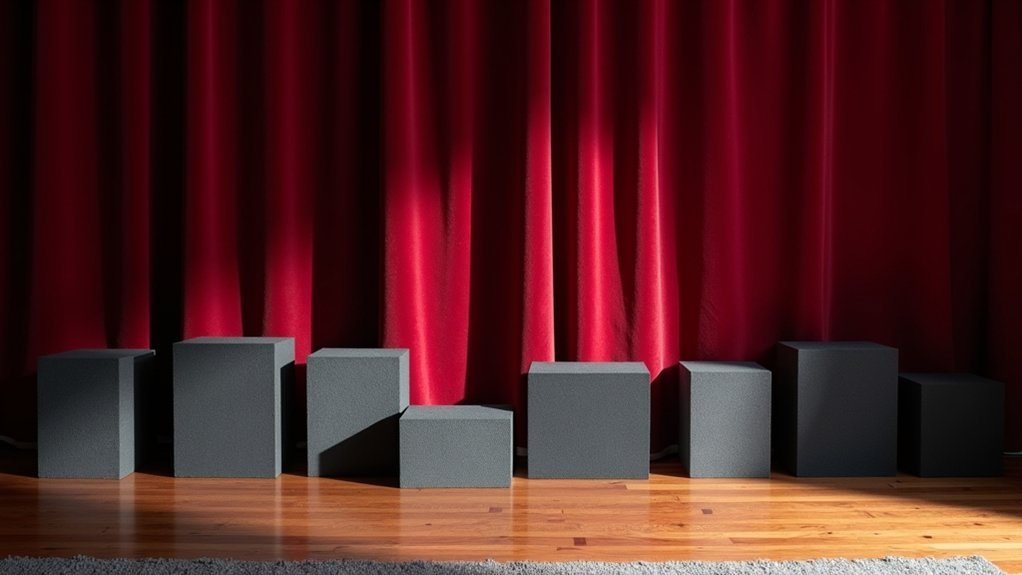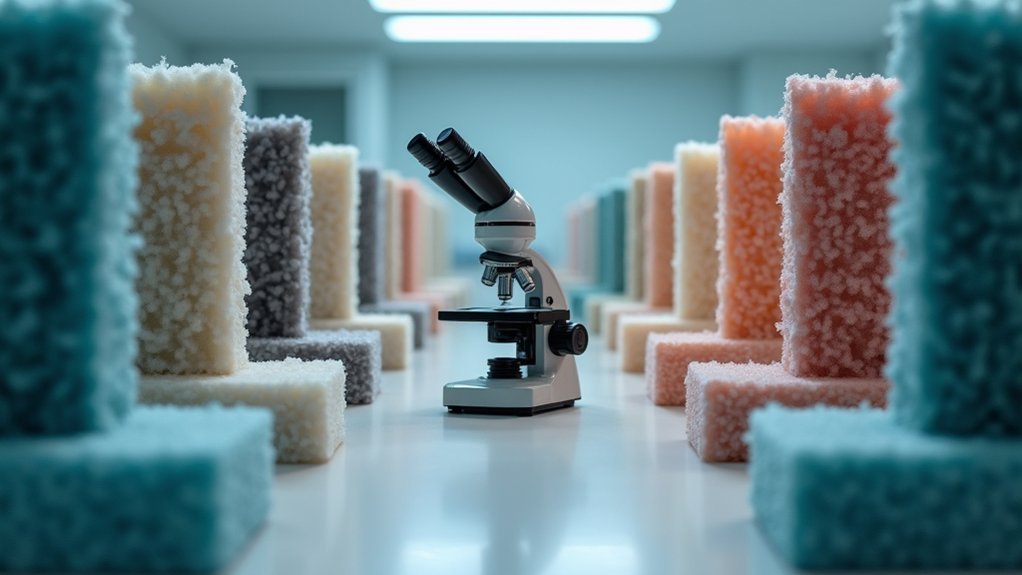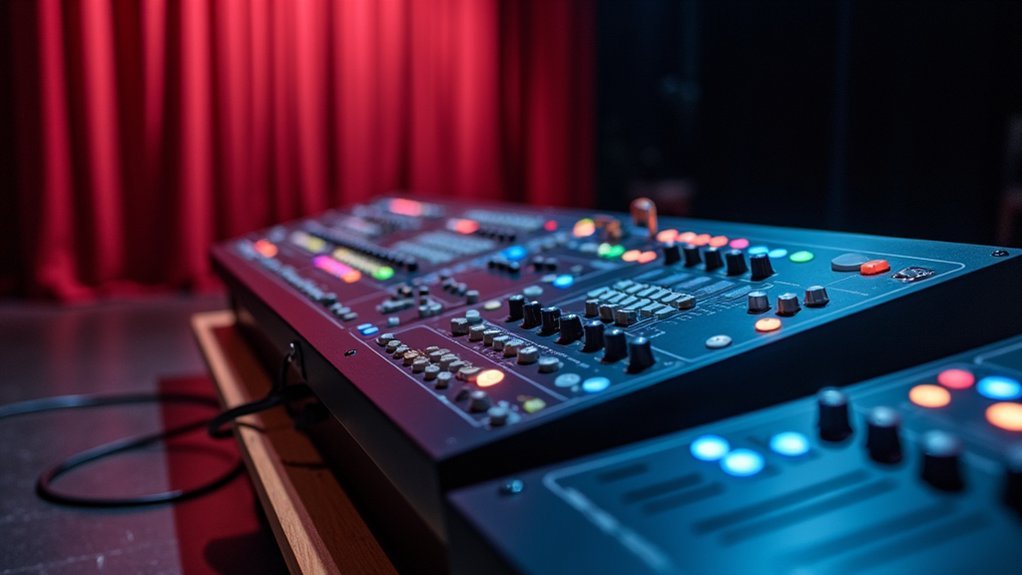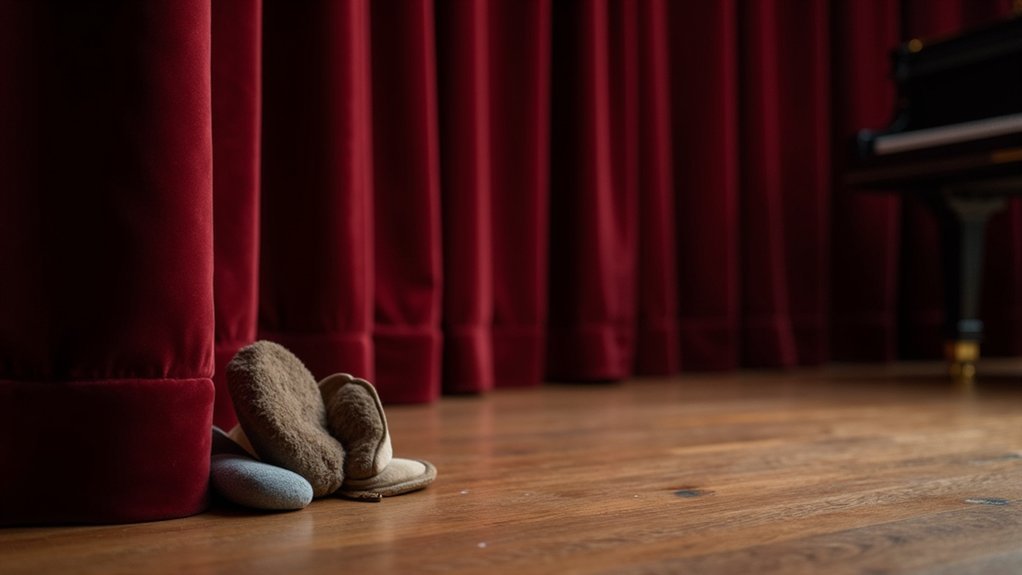To silence noisy stage movements, install vibration dampening materials under platforms, optimize gear mechanisms in stage controls, and apply silicone-based lubricants to moving parts. Use sound-absorbing barriers strategically around the stage, upgrade to precision bearings for smoother operation, and implement electronic control systems for minimal manual adjustments. Don’t forget to maintain regular inspection schedules for all components. These practical solutions will transform your performance space from distractingly noisy to professionally quiet.
7 Ways To Silence Noisy Stage Movements

Why do so many worship services suffer from sound quality issues? Often, it’s because excessive stage noise disrupts the worship experience.
Three main culprits contribute to this problem: acoustic drums, guitar amplifiers, and monitor wedges.
You can tackle drum noise by implementing sound deadening strategies like using softer mallets or adding dampening materials.
For guitar amps, consider isolation solutions—placing them in separate rooms or using isolation cabinets prevents sound bleed.
Perhaps the most significant improvement comes from replacing traditional monitor wedges with in-ear monitoring systems. This change dramatically reduces stage volume while giving performers clearer sound.
Don’t underestimate the power of communication—talk openly with your worship team about volume control.
For more detailed solutions, check the link in the description for thorough guides on creating a balanced sound environment.
Implementing Vibration Dampening Materials on Stage Platforms
When you’re selecting vibration dampening materials for your stage platform, consider factors like thickness, density, and compatibility with your specific flooring system.
You’ll achieve ideal results by installing these materials between floor layers, securing them firmly with appropriate adhesives, and ensuring complete coverage of high-traffic areas.
Regular inspection of your dampening materials for wear, compression, or deterioration will help you determine when replacement is necessary to maintain effective noise reduction.
Material Selection Guidelines
Selecting the right vibration dampening materials for your stage platforms can make the difference between disruptive performances and seamless theatrical experiences. You’ll want to prioritize materials that effectively absorb sound while maintaining structural integrity.
| Material Type | Best Used For | Key Benefits |
|---|---|---|
| Mass-loaded vinyl (MLV) | Barrier layers | Blocks sound transmission effectively |
| High-density rubber | Floor underlayment | Reduces impact noise from footfalls |
| Acoustic foam | Wall/edge treatments | Absorbs frequencies that cause echo |
For ideal results, combine lightweight high-density materials in your stage construction with strategic placement of dampening elements under risers. Don’t overlook the importance of treating the entire stage system—materials placed between floor joists and under platforms will greatly reduce vibration transfer from movement and equipment.
Installation Best Practices
Proper installation of vibration dampening materials requires careful attention to technique and order of operations, because even the highest quality materials will underperform if incorrectly applied.
Begin by thoroughly cleaning your stage platform before laying down underlayment materials. You’ll want to install dense underlayment beneath the entire flooring surface, ensuring complete coverage without gaps.
When placing rubber mats or acoustic foam, overlap edges slightly to prevent sound leakage between sections.
For heavy equipment, position sound isolation pads strategically under contact points, not just randomly beneath items. Allow flexibility in your installation design—platforms that can move slightly will absorb impact better than completely rigid structures.
Don’t forget to schedule regular inspections of your dampening materials, as worn components lose effectiveness over time and may need replacement.
Maintenance and Replacement
Even the most effective vibration dampening materials eventually deteriorate, requiring regular attention to maintain their noise-reducing properties.
You’ll need to inspect your rubber mats, foam underlayments, and mass-loaded vinyl regularly for signs of wear or damage.
Tighten any loose components on your stage platform quarterly, as these can create unwanted rattles and vibrations during performances.
Replace worn-out vibration isolation pads beneath speakers and amplifiers before they lose their absorption capabilities.
When sound-absorbing panels show deterioration, don’t delay replacement—their effectiveness diminishes considerably over time.
For ideal noise reduction, establish a maintenance schedule that includes checking the integrity of all dampening materials.
Remember that properly maintained vibration control systems not only reduce noise but also extend the lifespan of your stage installation, saving you money in the long run.
Optimizing Gear Mechanisms in Mechanical Stage Controls
You’ll find that regularly greasing moving components in stage controls eliminates those distracting squeaks and grinding noises that can ruin a performance’s audio quality.
Replacing worn pulleys before they develop wobbles or clicking sounds prevents unexpected disruptions during critical moments on stage.
Implementing cushioned cable management systems keeps wires from slapping against hard surfaces and creates a smoother, quieter operation when stage elements need to move during shows.
Greasing Moving Components
Mechanical stage controls often break down from friction and overuse, creating distracting noises that can ruin theatrical performances. Regular application of lubricant to moving parts is essential to minimize disruptive sounds during shows.
You’ll find that high-quality, silicone-based lubricants offer superior protection for gear mechanisms while greatly reducing operational noise. Apply these products strategically to hinges, sliders, and joints to guarantee smooth movement and eliminate squeaks or grinding sounds that distract audiences.
Develop a consistent maintenance schedule that includes proper greasing of all mechanical components. This proactive approach addresses potential noise issues before they become problematic.
When selecting lubricants, consider your specific environmental conditions—some greases attract dust or moisture, potentially worsening noise problems rather than solving them. Choose the right product for your venue’s unique requirements.
Replacing Worn Pulleys
When pulley systems begin to degrade, they often create distinctive grinding or scraping noises that can destroy the ambience of critical theatrical moments. You’ll need to regularly inspect and replace these components to maintain smooth, silent operation.
| Pulley Issue | Solution |
|---|---|
| Visible wear | Replace immediately |
| Misalignment | Realign during installation |
| Poor material | Upgrade to high-quality alternatives |
| Inconsistent movement | Check for debris and clean |
| Squeaking | Apply appropriate lubricant |
Install replacement pulleys with precise alignment to prevent unnecessary noise. Opt for high-quality materials that resist wear, which will extend the time between replacements and preserve sound quality. Implementing a regular maintenance schedule for your pulleys will greatly reduce disruptions during performances and enhance the audience experience. Don’t wait until pulleys fail completely—proactive replacement saves both time and potential embarrassment.
Cushioned Cable Management
Cables, the silent conductors of stage mechanics, often become the most disruptive noise culprits during performances. You’ll dramatically reduce these unwanted sounds by implementing cushioned cable management systems that minimize vibrations and friction during movement.
Start by using cable sleeves or wraps with built-in cushioning to absorb impact sounds before they transmit through your stage equipment. Route cables strategically to avoid sharp edges, and secure them with cable clips to prevent rattling noises that disrupt the audience’s experience.
Don’t overlook the power of flexible connectors and rubber grommets to dampen noise from mechanical movements.
Make regular inspection of your cable systems part of your maintenance routine—this guarantees you’ll quickly address any wear that might contribute to noise issues before they impact your production.
Applying Lubricants to Reduce Friction in Moving Parts
One of the most effective strategies for minimizing unwanted noise on stage involves proper lubrication of moving components. When you apply lubricants to hinges, wheels, and other moving parts, you’ll greatly reduce friction that causes distracting sounds during shifts.
For best results, clean surfaces thoroughly before applying lubricants. Choose silicone-based options for high-friction areas where you need long-lasting noise reduction. They create smooth, quiet movements that won’t disturb performances.
Consider dry lubricants like graphite or Teflon for areas where dust accumulation is a concern, as they won’t attract debris while still providing effective noise reduction.
Regular maintenance with appropriate lubricants not only silences your stage movements but also extends your equipment’s lifespan by preventing the wear and tear caused by excess friction.
Installing Sound-Absorbing Barriers Around the Microscope

Creating an acoustically isolated environment for your microscope requires strategic placement of sound-absorbing barriers.
These specialized barriers can reduce noise interference by up to 30 decibels, dramatically improving sound quality during performances and recordings.
- Choose appropriate materials like acoustic foam or heavy curtains that effectively dampen sound reflections and minimize stage noise.
- Position barriers strategically around your microscope to isolate it from other instruments, creating a more balanced audio mix.
- Guarantee complete coverage around the microscope to maximize sound absorption while still maintaining necessary access for performers.
- Implement a regular maintenance schedule to check for damage or shifting of barriers that could compromise their effectiveness.
Don’t underestimate the impact these barriers can have on your overall acoustic environment—proper installation leads to clearer, more professional sound production.
Upgrading to Precision Bearings for Smoother Movements
The vital difference between amateur and professional stage productions often lies in the details audiences barely notice—until they’re missing.
Those distracting squeaks and rumbles from moving platforms can instantly break the theatrical illusion you’ve worked so hard to create.
You’ll find that upgrading to precision bearings delivers multiple benefits.
These engineered components considerably reduce friction, resulting in noticeably smoother and quieter stage movements. They’re manufactured to tighter tolerances, minimizing vibration and play that cause distracting noise during essential performance moments.
Beyond immediate noise reduction, you’ll appreciate the long-term advantages.
Precision bearings enhance equipment longevity, reducing maintenance frequency and preventing wear-related noise. They also improve load capacity, maintaining quiet operation even with heavier stage elements.
Your audience will thank you with their undivided attention.
Using Electronic Control Systems to Minimize Manual Adjustments

While manual stage adjustments have served theaters for generations, electronic control systems now represent a revolutionary step forward in producing seamless performances.
By implementing these systems, you’ll dramatically reduce stage noise that often disrupts the audience’s immersion.
- Install DSP-integrated controllers that automatically enhance audio clarity while filtering out equipment noise, eliminating the need for disruptive mid-show adjustments.
- Set up programmable presets for different performance segments, allowing instant changes between sound profiles without manual interference.
- Utilize remote control capabilities so your sound engineers can make real-time adjustments from ideal listening positions rather than moving around the stage.
- Implement automated mixing systems that maintain perfect balance between instruments and vocals, preventing sudden volume changes that might startle audiences.
Frequently Asked Questions
How to Reduce Stage Noise?
To reduce stage noise, use drum pads and muffling techniques, isolate guitar amps, switch to in-ear monitors, communicate with musicians about volume control, and utilize direct inputs from pedals instead of mic’d amps.
How to Have Quieter Footsteps?
You’ll achieve quieter footsteps by wearing rubber-soled shoes, walking heel-to-toe, stepping on carpet or rugs, practicing mindful movement, and distributing your weight evenly. Try placing damping pads in high-traffic areas too.
What Are the Methods of Minimizing Noise?
You can minimize noise by using in-ear monitors, isolation cabinets for amps, direct input for guitars, acoustic panels, and softer drumheads. Don’t forget to communicate with musicians about maintaining appropriate volume levels.
How to Make No Sound When Walking?
You’ll make no sound when walking by wearing soft-soled footwear, stepping heel-to-toe gently, leaning forward slightly, and landing on the outer edge of your foot. Practice walking deliberately and mindfully with each step.
In Summary
By implementing these seven solutions, you’ll transform your microscope stage from a noisy distraction into a silent precision instrument. Whether you’re dampening vibrations, upgrading bearings, or adding electronic controls, each method addresses different noise sources. Don’t let mechanical sounds interfere with your focus—these practical modifications will create the quiet environment you need for sensitive observations and accurate results.





Leave a Reply